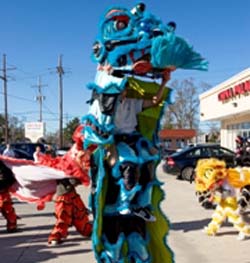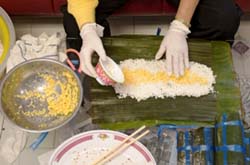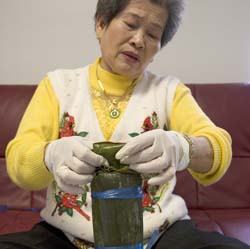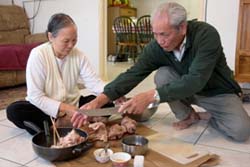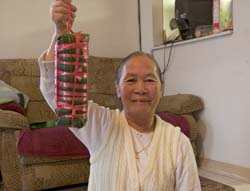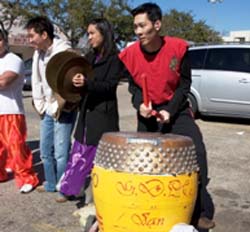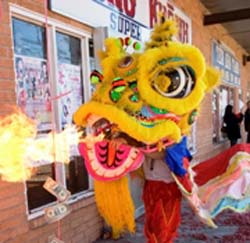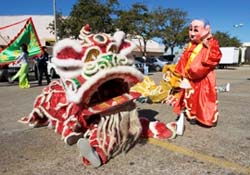Tet, the Vietnamese New Year, in the New Orleans Vietnamese Community
By Dr. Kathleen Carlin and Cam-Thanh Tran
with the advice of Father Vien The Nguyen and Brother Thieu Nguyen
Chúc mung nam moi! Happy New Year!
As the new year begins and the old year is put to rest, all Vietnamese rejoice in their most important holiday - New Year. The living pay homage to the dead, and younger community members honor their elders. Families are reunified; the coming of spring and the planting season are celebrated. This is a time for relaxation, joy, and hope. Tet is the time to settle past mistakes and start anew. It is the height of feasting, parties, and gift giving-especially for children, who are rewarded with red envelopes containing "lucky money." Traditionally, this was the time when everyone counted himself or herself one year older. Houses are meticulously cleaned, business accounts are settled, homes are decorated with flowers and budding saplings, and everyone buys new clothes. To celebrate the New Year as a family is an essential part of the Vietnamese experience and a way of validating one's place in the most important group-the family. Everybody who is able to do so goes back home to visit parents and grandparents. Extended families come together to enjoy each other's company and to pay ceremonial respect to the elders of the family and the ancestors; churches or temples are filled with worshippers. People visit family and friends, eat special holiday dishes, give gifts, and play games of chance. Firecrackers welcome the New Year. A good Tet augurs a good year ahead.
Tet, or more accurately Tet Nguyên án, the Vietnamese Lunar New Year, is the most important holiday in Vietnam. Officially filling the first three days of the lunar calendar, which is shared with China, Japan, and Korea, the holiday unofficially continues for more than a week. Vietnamese, and also Western writers, trying to explain how important Tet is to Vietnamese culture, often describe it as a combination of New Year's Day, Christmas, birthdays, Easter, Thanksgiving, and the Fourth of July. Not only is it the time for reunion with family, but also for material and spiritual renewal. Its traditions, folklore, foodways, music, and dances hark back centuries in Vietnamese history and are central to Vietnamese culture. Some customs are shared with China; many are unique to Vietnam. Even after more than thirty years of living in New Orleans, this holiday is still extremely important to the Vietnamese living here in the United States and, if anything, has grown more vibrant as the Vietnamese community has become more stable.
The word Tet comes from another Vietnamese word, "tiet," which means "a unit." There are four seasons (units of the year) and, therefore, there are four Tets. By far the most important of them is Tet Nguyên Đán, because it marks the beginning of the New Year, and it is often referred to simply as "Tet". Since Vietnam has been an intensely agricultural country for thousands of years, the New Year starts at the beginning of spring when the next season's crops have been planted and have begun to grow. Midnight between the last day of the old year and the first day of the new one is full of profound meaning. That moment, that millisecond, represents the meeting of winter and spring, of hunger and plenty, of death and life. This is when people stand before household altars to their ancestors, offering incense and prayers, reporting what went on in the family during the past year, and asking for good fortune in the future, because the spirits of one's ancestors still live and remain closely connected to their descendants.
Importance of Tet to Vietnamese and Vietnamese-Americans
Tet Nguyên Đán is celebrated on the first day of the lunar calendar-it always falls between January 19th and February 20th on the western calendar-and officially lasts for the first three days of the New Year. However, preparation for the festival fills the weeks before the actual holiday, and the celebration itself lasts longer than three days. Therefore, Tet is a month-long celebration, a comprehensive holiday which Vietnamese enthusiastically embrace. Vietnamese, living in the United States and elsewhere, remain very emotionally tied to celebrating Tet. It is the central festival in Vietnam and, for even the most acculturated Vietnamese settled in other countries, it remains the major occasion on which to celebrate their Vietnamese heritage. Tet is a moveable holiday (like Easter), which presents some difficulty in celebrating the holiday while living in a country with a different holiday calendar. Be this as it may, Vietnamese communities make a concerted effort to celebrate Tet, and most family members undertake long trips to be with their relatives during this time.
The Vietnamese are one of the largest ethnic/immigrant groups in New Orleans, numbering more than 14,000 according to the 2000 census. They began settling here soon after the Vietnam War ended in 1975. In the thirty years that they have lived here, they have developed a strong, resilient ethnic community, which has added to the city's cultural diversity and color. Because the nuclei of these settlements were villagers from three Catholic fishing villages in South Vietnam, the New Orleans Vietnamese community is distinct from other Vietnamese neighborhoods in the United States. They have established three communities in New Orleans: the largest, and most organized, is located in the Versailles neighborhood of New Orleans East near Chef Menteur Highway and community life here centers around the Mary Queen of Vietnam Catholic Church and the Van Hanh Buddhist Center. The three predominantly Catholic Vietnamese communities-the order is usually Woodlawn, then Marrero, then Mary Queen of Vietnam-each put on a weekend-long fair for the three weekends close to Tet. The three Buddhist temples-Bo De Temple in Belle Chaise, Lien Hoa Temple in Gretna, and Van Hanh Temple in New Orleans East-also put on community events for Tet on a somewhat smaller scale.
The Vietnamese community in New Orleans East was severely affected by Hurricane Katrina in 2005. Most houses and businesses in the Versailles area had some flooding and also suffered wind damage. Mary Queen of Vietnam Catholic Church and its rectory did not flood, but suffered wind damage. Most of the population evacuated and many relocated to Texas, Mississippi, Alabama, and to other towns in Louisiana. Almost two years later (spring 2007), many displaced people are still commuting from temporary residences on weekends to repair their homes and businesses and to attend their home churches. The resilience of the community has been remarkable. The church is full for its weekend masses, and most homes appear to be in good shape again; most businesses in the mini-malls have reopened. Father Vien The Nguyen, the pastor of Mary Queen of Vietnam and head of the East Bank Vietnamese diocese, says that over 90 percent of the community had returned or were in the process of returning by the end of the year 2007. Another sign of the community's recovery are the three-day-long Tet fairs since Hurricane Katrina. In 2006 - only five months after the disaster - the fair broke records with 20,000 people attending.
Preparation - Food and Activities
Preparations and parties fill the weeks before Tet, building to a crescendo of firecrackers at midnight on the eve of the New Year outside the temples, churches, and community fairs where people have gathered. However, the actual three days of Tet are fairly quiet family affairs. In New Orleans, the days on which Tet falls affect the celebrations. The family as a group is welcoming the ancestors for a visit, and so the whole family is reunited. Most people will go to work or to school if Tet falls on a weekday, and will do their celebrating on the weekends before and after the actual days of Tet. Still, even if Tet falls on a work day or school day, most people will make efforts to start their new year well-avoiding angry words, paying respects to family and important people, and refraining from unlucky actions.
In Vietnam, people travel to their ancestral villages to gather with their extended family; here in the United States, people try very hard to be with their relatives during Tet. To start the new year off in the best way, families clean and fix up their homes, decorate with flowers and budding trees-especially hoa mai, a small, yellow flowering plant that symbolizes prosperity and well-being for the family-and prepare special holiday foods for visitors and celebration. There is a belief that sweeping and breaking things should be avoided as the new year nears, for fear that good luck and prosperity might be broken or swept out of the house, so intensive cleaning has to take place earlier. Families buy new clothes, and even the old sack of rice is finished and a new sack bought to begin the New Year. Many homes also display long strips of red paper on either side of the front door. These papers, called câu doi, are embellished with decorative script (resembling Chinese characters) in couplets about good fortune for the individual, family, or business. Children eagerly look forward to Tet, when they get new clothes, there is plenty of good food to eat, and their elders give them lucky money. Also, in Vietnam school is cancelled for at least three days.
Almost every Vietnamese home, whether Catholic, Buddhist, Cao Đài, or without a specified religion, has a family altar, which typically is in the living room. It holds pictures of important family members, who have died in the last one or two generations, as well as offerings (usually incense and flowers, perhaps dishes of food) for these ancestors, and also religious pictures and statues. Before Tet, each family carefully decorates its family altar and sets out offerings, particularly including the traditional gift of betel nut on a bit of limestone powder wrapped in areca leaves. Because Tet is such an important time for very important ancestors, the areca-leaf wrapping is done in a special way called cánh phuong (phoenix wings), a manner of presentation that shows special respect. A betel nut, wrapped sprinkled with lime powder and wrapped in an areca leaf, is a mild stimulant, which has been chewed throughout Southeast Asia for ages. Although only a few elderly people in New Orleans use it much, it continues to be an important gift or offering at important celebrations. In Vietnamese culture it symbolizes family virtues. A popular traditional story, which was told by several people who were interviewed for this project and here summarized by this author, illustrates this connection:
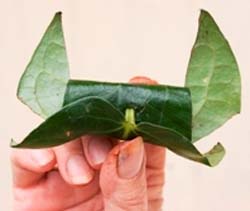
The legend says that, long ago during the time of the Hung Vuong kings, twin brothers fell in love with the beautiful daughter of their teacher. The brothers were as alike "as two drops of water," but the girl and her family agreed that she should marry the elder brother. She identified which brother was the older by inviting them to dinner with her family and observing that one brother picked up chopsticks and presented them to the other (thus demonstrating he was the younger, showing respect to his elder). After she and the elder brother married, they shared their family house with the younger brother. One day the brothers were working in their fields and the younger brother felt ill so went home early. The young wife, thinking he was her husband, ran out and greeted him (as Fr. Vien told it) "in an intimate way." This embarrassed the younger brother so much that he left the house and walked for many days, until at last he sat down beside a river, collapsed, and died. He was turned into a limestone boulder.
The wife told her husband what had happened, and he waited for his brother to return. Days passed, and finally the older brother went out searching for the younger. After many days, he also came to the same river, where he too collapsed and died beside the rock, turning into an areca tree. Finally the wife went out to follow her husband. She reached the same place, where she sat down, leaned against the tree and died, becoming a betel-nut vine twining up the tree beside the stone.
Later, King Hung Vuong VI was traveling through the country and paused under the shade at this spot. The local people told him the story of what had occurred and offered him betel nut wrapped in areca leaf. When he spat out the juice upon the limestone boulder, it turned red, "as bright as blood." The king ordered that from then on, all marriages and other important celebrations would include offerings of betel, lime, and areca, symbolizing the close familial relationship not only of spouses but also of siblings, because they are all bound by blood ties.
This myth involves basic concepts of Daoism, such as the five elements and the balance of yin and yang, which explain the universe. The five elements are wood, water, fire, metal, earth, and all but air are intertwined in this story. Yin and yang are the eternal oppositions, which complement each other and make up the universe. Yin is female, dark, cold, wet. Yang is male, bright, heat, dry. Too much of either yin or yang in anything causes things to be out of balance and misfortune occurs. When there is a balance between yin and yang, the harmony and wholeness of the universe is represented. So, by the several oppositions in this story of male and female, tree and vine, plant and stone, sibling love and marital love, harmony is arrived at.
As Tet draws closer and preparations increase, preliminary activities begin. Eight days before Tet begins (i.e., on the 22nd day of the 12th lunar month), Vietnamese Buddhists pray at their home altars or go to a temple because they will not say prayers for the next week. They say that Ong Tao, the kitchen god who observes each family all year and takes notes, leaves the home on the 23rd day, and goes to make his report to the Emperor of Heaven. Ong Tao returns on the last day of the old year, bringing with him the family's ancestors, who will visit in the home for the first week of the New Year. (Brother Thieu Nguyen was careful to explain that the ancestors know everything their family members are doing on earth even while they are in heaven, so they visit to be close to their family rather than to gather data about them.) Therefore, as well as preparing for relatives and friends to visit during Tet, the family is preparing to welcome their ancestors' return.
Actions that can increase good luck or ward off bad luck are emphasized, and correct behavior is followed in order to begin the new year well. Debts and business dealings should be settled, and mistakes should be corrected. (In fact, traditionally a lender could not demand payment of a debt for the first week, or sometimes for the first month, of the New Year.) Peace and cordiality is the rule. Since good fortune or ill luck always seems somewhat capricious, whatever can be done to encourage or entice good luck into one's home and to shoo away bad luck is done. Noise is supposed to scare evil spirits away. This, as well as children's love of noise and excitement, is the reason for firecrackers. Lì xì (lucky money) is given by elders to children in small, decorated red envelopes. The amount of money can be a few pennies or more than a hundred dollars, depending on relationships and wealth; however, it is the symbolism of being given wealth that is most important. In somewhat similar fashion, a lot of gambling-both very familiar forms of betting and much more traditional Vietnamese games of chance-goes on during the holiday season because some people feel that their luck in the games foretells their fortune to come.
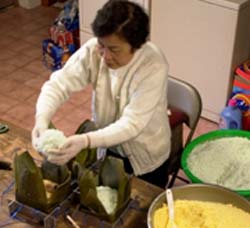
Many holiday foods are prepared during Tet. bánh chung is the quintessential food of Tet. This square cake made of sticky (glutinous) rice, with a center of chopped pork and mashed beans, is wrapped in banana leaves and tied up with string or bamboo strips, then boiled for eight hours. Because of its leaf wrapping, the rice cake takes on a light green color. It is often served together with bánh dày, a rather bland, round, white rice cake. In the Versailles community, Mrs. Mat Pham (Mrs. Vien) makes bánh chung for her family and friends during the week of Tet. She assembles the ingredients into packed rice cakes and wraps them in banana leaves using bamboo strips, before boiling them for twelve hours in a deep pot.
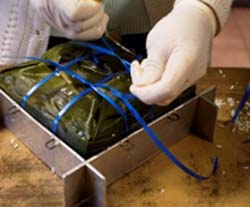
The legend tells that, three thousand years ago, King Hung Vuong VI of ancient Vietnam had grown old. He called all of his sons together and announced that he would bestow his throne on the prince who brought him the most delicious food. All of the princes traveled far and wide, to the high mountains and the deep sea, to find the rarest, most delectable foods. The king's older sons got help from their mothers, but the youngest son received little advice or assistance because his mother was dead. However, one night he had a vision in which a fairy came and taught him how to make bánh chung and bánh dày. He prepared these and presented them to his father, explaining that the square, green bánh chung symbolizes the earth and the round, white bánh dày symbolizes the heavens. The king was so impressed by the inherent wisdom in this simple food made with the basic materials of life-rice, meat, beans, and leaves-that he gave his youngest son the throne.
When Fr. Vien The Nguyen told this story (here summarized by the author, as are the other stories), he emphasized the truths within it: The bánh chung is the earth, yin, the nurturing mother, and therefore by extension the farming people who are the wealth of the country; the bánh dày is the heavens, yang, the radiant father. The kingdom was passed on, not to the oldest, but to the one wisest about farming, weather, people, and life. Also, the special way that each bánh chung cake is tied with four strings, creating a grid of nine squares on each side, is evocative of the traditional system of rotating land use within a village, reserving a central area for the common good and allowing each farmer access over the years to better and worse soils.
Mrs. Binh Van Nguyen makes bánh tét rice cakes. First, very early in the morning, she soaks rice and mung beans in cold water. Then she spreads out a square layer of rice. On top of that, she places a long thin layer of sliced pork and spoonfuls of crushed mung bean down the center, then forms a roll of rice by packing more rice on top and around the meat center. She wraps the rice roll in a tube of four banana leaves and ties it fairly tightly with string, leaving enough space for the rice to expand a little. The long rolls of bánh tét rice cakes are then boiled for eight to ten hours. Many times family members will stay up late to tend the fire and tell stories while the rice cakes cook, passing on oral traditions and family lore.
Mr. and Mrs. Dao Van Nguyen make giò thu pork rolls, which are traditionally made in northern Vietnam. First, pieces of pig ear, nose, and other portions of the head are cut into thin strips and boiled with cornmeal. After this has boiled for a while, about two pounds of the sausage is packed into a tube or can and refrigerated at least overnight. It is usually served with pickled shallots. A somewhat similar dish is thit Đông, "frozen pork," a jellied pork dish similar to hogshead cheese, which is served with pickled mustard and pickled onions.
Candied coconut, bananas, mango, peaches, ginger, and many more are usually offered. Also, watermelon slices and dried watermelon seeds are served to Tet visitors, and it is thought that the redder the watermelon when it is cut, the more luck will come in the new year. This notion is explained in a well-known legend:
A Hung Vuong prince was wrongfully exiled by his father the king, to a lonely island. There he found strange seeds, planted and nurtured them, and grew large, delicious watermelons. He decided to carve his name on the melons and let them float to the mainland. On the shore, villagers found the strange fruits, sampled them, and took the delicious food to the king. When the king saw his son's name carved on the rinds, he relented from his decree and brought the son back in honor.
Celebrating the Days of Tet
As the days get closer to Tet, there are more festivals and festivities for people to enjoy, and excitement builds as the old year comes to a close. Before midnight on the eve of Tet, people go to their church or temple for a special service. The Catholic Church in Vietnam has a special liturgical service for Tet, but here in the United States the Tet Eve mass follows the regular liturgical calendar. Br. Thieu Nguyen of the Lien Hoa Buddhist Temple described the special New Year's Eve service as beginning with a homily by a monk about the meaning of Tet traditions and the importance of following good examples in the New Year, followed by prayers offered for an auspicious new year. Between this evening service and midnight, the dragon dancers usually arrive and, amid deafening firecrackers, enter the temple where the dragon dances and is given dollars by people who want to attract special luck through this personal contact with the dragon. At midnight, the children are given red envelopes with lì xì (lucky money), and congregants receive apples or oranges. People leave the temple after midnight, usually after making their personal prayers and lighting incense sticks in front of the altar to Buddha and various bodhisattvas (who can be described as Buddhist saints). Once home, many families will offer prayers, flowers, and food-especially rice dishes and fruit-and sometimes money on their family altars.
In Vietnam, preparations for Tet occasion a month of bustle and hurry, but when the new year actually arrives the whole country stops for three days to enjoy the week, or weeks, following. People are on their best behavior; everyone tries to speak nicely to each other, to refrain from gossip, and not to punish their children (and of course children should not be deserving of punishment, either). The first day augurs the New Year, and the first visitor to enter a home is considered extremely important. People primarily socialize with family on the first day, and only invite specific visitors who are felt will bring good fortune with them (i.e., because their names are auspicious, because they are prosperous, or because they have large, healthy families). (The Lonely Planet guidebook to Vietnam advises travelers not to visit anyone in Vietnam on the first day unless explicitly invited, and then to confirm the time.) There is much more visiting on the second and third days of Tet. In Vietnam there are additional special liturgical prayers in the Catholic church on each of the first three days of Tet.
Here in the United States, celebrating Tet is a bit different because the general culture does not mark the holiday. People continue to go to work and school if Tet falls on a weekday, and the grander celebration is held off until the weekend. As Br. Thieu Nguyen said, "In Vietnam, the family must get together; here, the family should get together." The three Vietnamese Catholic churches in New Orleans take turns holding fairs for the two weekends before and the weekend after Tet, with Woodlawn usually first, Marrero second, and Mary Queen of Vietnam having the largest fair the weekend after Tet. There are tents and booths selling food, booths of games, community displays, and staged entertainment by both community and professional singers and musicians. The New Orleans East Tet fair in 2006, just five months after Hurricane Katrina, had a record 20,000 attendees over the course of three days.
Gradually the excitement levels off, visitors go home, life returns to normal, and everyone will find out just how much good fortune the new year has brought them. But everyone is also anticipating the next great holiday-only a year away. The holiday of Tet Nguyen Dan embodies key elements of Vietnamese identity-family, cultural heritage, contact with the religious and spiritual world, pleasure in social activities-and if anything the festival is growing stronger in communities of the Vietnamese diaspora, as the generations settle, succeed, and share their celebration with their neighbors.


